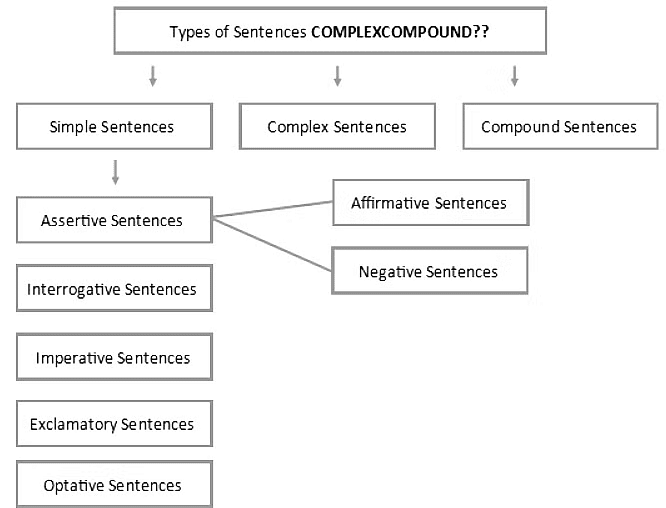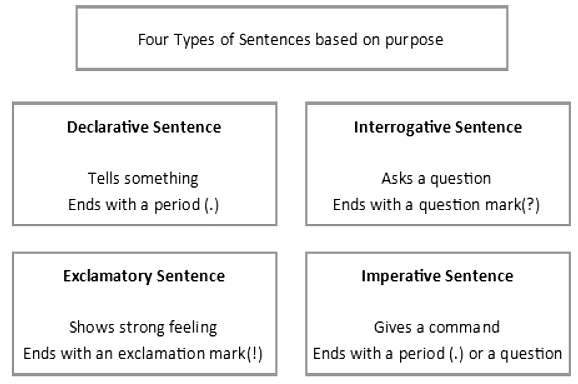Introduction and Types: Sentences | English Language & Comprehension for SSC CGL PDF Download
Introduction
A sentence, the largest unit of language, commences with a capitalized word and concludes with a full stop (.), question mark (?), or exclamation mark (!). Typically, it comprises words arranged in a grammatically coherent manner, expressing an assertion, affirmation, query, or remark. To be grammatically correct, a sentence adheres to a structured pattern, necessitating a subject, verb, and object.
Sentences adhere to specific structures that aid in comprehending the speaker's or writer's mood and intention. Recognizing the type of sentence employed provides insights into whether the aim is to inquire, state, or convey another purpose.

Types of Sentences
1. Simple Sentences
A simple sentence contains a subject and a verb. It expresses a single complete thought that can stand on its own.
Example: The baby cried for food.
- It contains a subject and a verb that expresses a complete thought.
Example: Professor Maple’s intelligent students completed and turned in their homework.
- A simple sentence does not necessarily have to be short. It can have adjectives. In this case, there are two verbs, completed and turned in. However, the sentence expresses one complete thought and therefore is a simple sentence.
Example: Megan and Ron ate too much and felt sick.
2. Compound Sentences
A compound sentence consists of two independent clauses. An independent clause, capable of standing alone as it contains a subject, a verb, and conveys a complete idea, constitutes the building block of this sentence type. Essentially, a compound sentence is formed by combining two simple sentences, each containing an independent clause, linked together by a coordinating conjunction (such as for, and, nor, but, or, yet, so).
Example: They spoke to him in Spanish, but he responded in English.
- This is also a compound sentence that uses a conjunction to separate two individual clauses.
Example: The shoplifter had stolen clothes, so he ran once he saw the police.
- Both sides of the conjunction are complete sentences. ‘The shoplifter had stolen clothes’ can stand alone and so can ‘he ran once he saw the police.’ Therefore, this is a compound sentence.
3. Complex Sentences
A complex sentence comprises an independent clause connected to one or more dependent clauses. A dependent clause may lack either a subject or a verb, or contain both but doesn't convey a complete thought on its own. In essence, a complex sentence is formed by combining an independent clause with dependent clauses that are linked using subordinating conjunctions (like as, because, since, after, although, when) or relative pronouns (such as who, that, which).
Example: After eating lunch at The Cheesecake Factory, Tim went to the gym to exercise.
- The independent clause is ‘Tim went to the gym to exercise.’ The subordinating clause before it is dependent on the main independent clause. If one were to say ‘after eating lunch at The Cheesecake Factory’, it would be an incomplete thought.
Example: Opinionated women are given disadvantages in societies that privilege male accomplishments.
- The subject is ‘opinionated women’ and the verb is ‘are given’.The first part of the sentence ‘opinionated women are given disadvantages in societies’ is an independent clause that expresses a complete thought. The following ‘that privilege male accomplishments’ is a relative clause that describes which types of societies.
Example: The woman who taught Art History 210 was fired for stealing school supplies.
- The dependent clause in this sentence is “who taught Art History 210” because if removed, the rest of the sentence would stand as an independent clause. “Who taught Art History 210” is an adjective clause that provides necessary details about the subject, woman.
4. Compound-Complex Sentence
A compound-complex sentence has two independent clauses and at least one dependent clause.
Example: The two soccer players lost their game, joined their other teammates for lunch, and they went to the movies.
- If we remove the dependent clause “after the two soccer players lost their game,” we have a compound sentence. The dependent clause makes this sentence compound-complex.
Example: The man believed in the system, and he knew that justice would prevail after the murderer was sent to jail.

Based on their Purpose, there are the following types of Sentences

1. Declarative Sentence
- The type of sentences that speak facts!
- They are statements, reasons, or answers given to someone.
- They are expressed as ‘yes’ or ‘no’ as a starting connotation.
They are an answer to an interrogative sentence. Example:
- “Will you please open the door, if you can!”
- “Yes, I will.”
Example:
- “Are you coming with us to participate in the fest?’
- “No, I better stay at home for some pending work.”
They are an answer to an exclamatory sentence. Example:
- “Alas! The poor beggar died.”
- “Oh, so sad! I know he did.”
2. Interrogative Sentence
- The only type of sentence that has the authority to answer a question
- They end with a question mark (?)
- Interrogatives expect an answer
- How, when, where, are you, will you, do you, have you, has he/she/it are immensely common in this type.
They ask general questions.
Example:
- “What is your name?”
- “Why do you live here?”
- “What do you think will happen to the Indian economy?”
They ask questions related to specific topics.
Example: “How many casualties did the area suffer?”
3. Imperative Sentences
- This type of sentence is a request, a command, an instruction, a possibility, and information
- Words like, please, let, do, go are immensely common in this type.
- Imperatives always follow an exclamation mark(!)
- They make a request.
Example:
- “Please, may I come in”
- “Could you please complete the task”
They order, command Example:
- “Go sit down!”
- “Shut the door!”
- They instruct.
Example:
- “This planned task is not to be done like this. Do it that way!”
- They inform us for the good or bad!
- “Don’t go there. You’ll catch a cold”.
4. Exclamatory Sentence
“They exclaim!”. “Oh really!, Do they?”. “Oh, yes!” This type of sentence can’t keep quiet without expressing itself. Whether it is good, bad, confusing, sad, happy, excited, whatever mood they are in, they express. They express happiness
Example:
- “Bravo! We won the match.”
- “Yippee! The team India won the world cup”.
- They express sadness
Example:
- “Alas! The poor animal died out of hunger”.
- “Oh, Alas! The poor beggar is not anymore”.
- “Oh, I am sorry, you had to leave your friends”.
|
133 videos|104 docs|150 tests
|
FAQs on Introduction and Types: Sentences - English Language & Comprehension for SSC CGL
| 1. What are the four types of sentences? |  |
| 2. What is a declarative sentence? |  |
| 3. How do you identify an interrogative sentence? |  |
| 4. What is an imperative sentence? |  |
| 5. What is an exclamatory sentence? |  |
|
133 videos|104 docs|150 tests
|

|
Explore Courses for SSC CGL exam
|

|

















